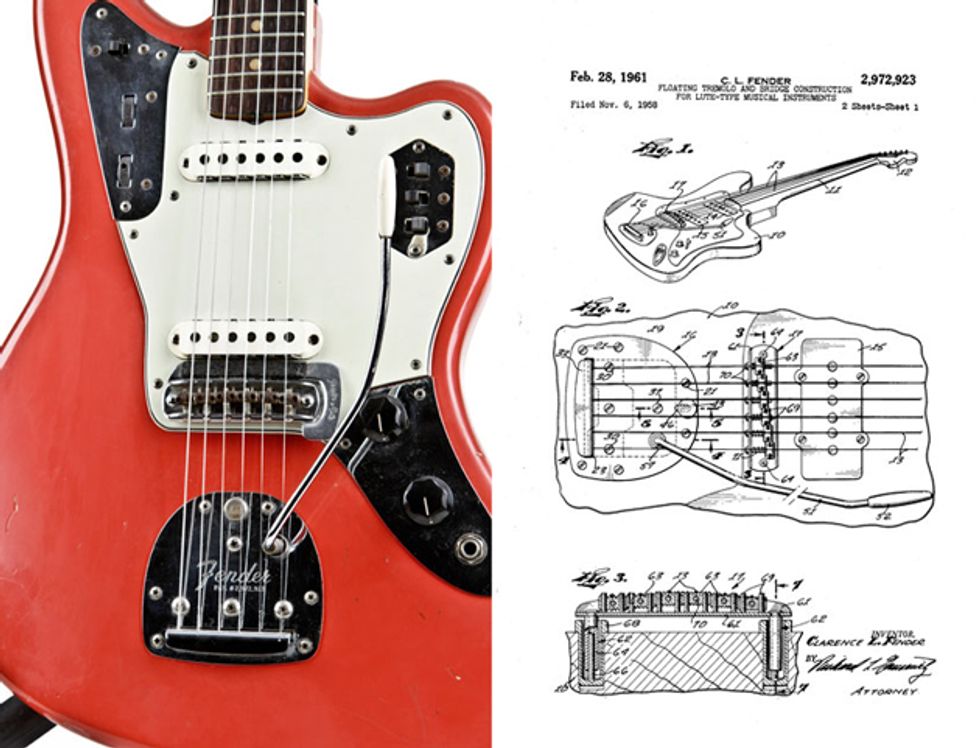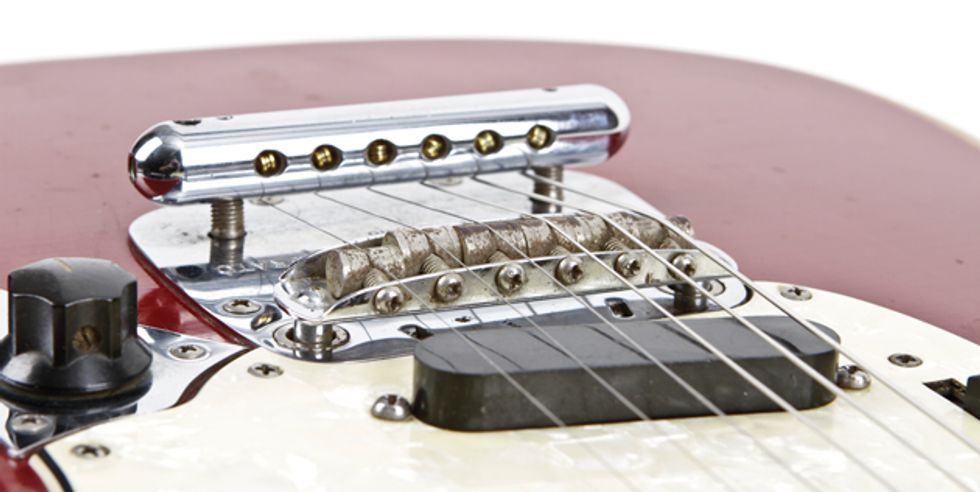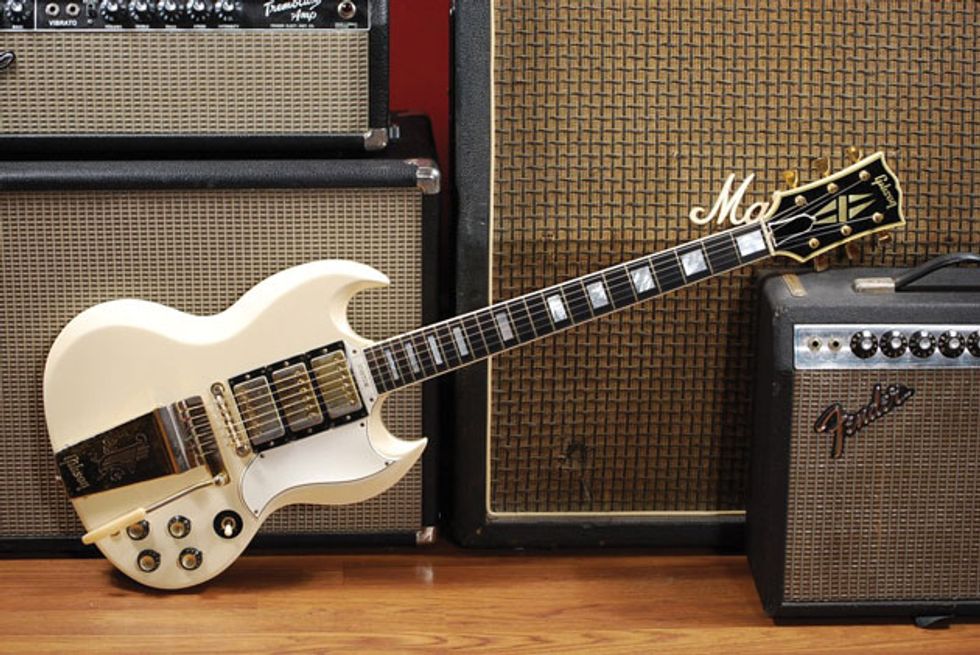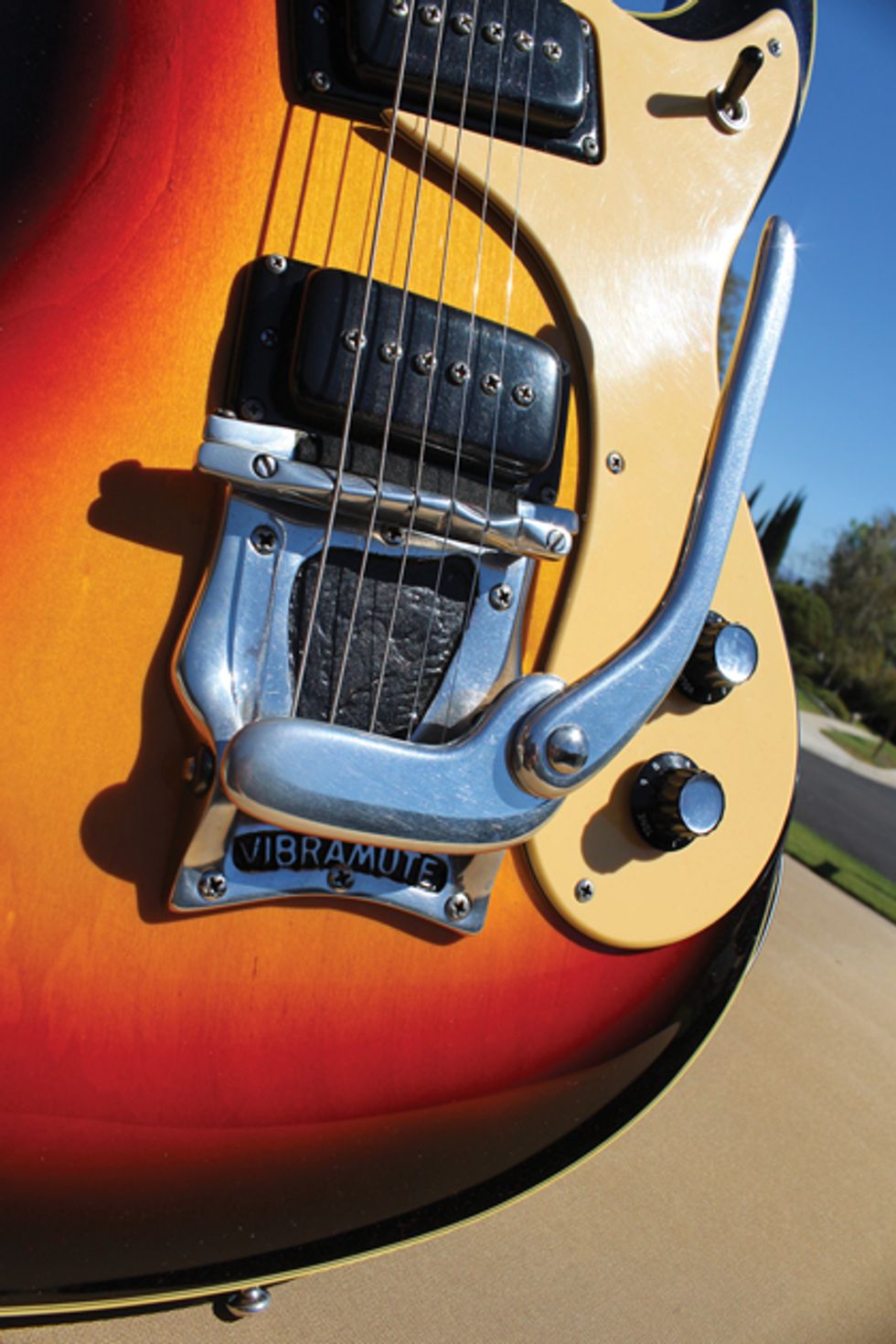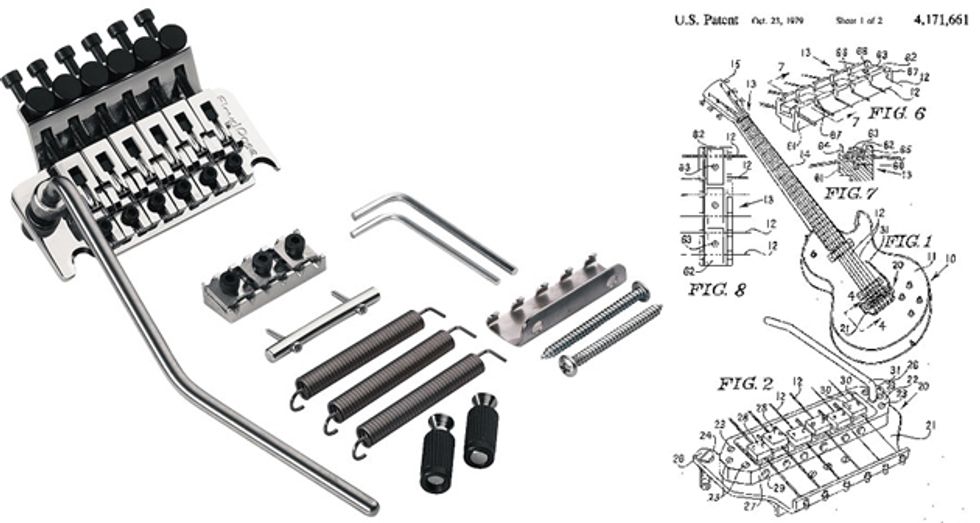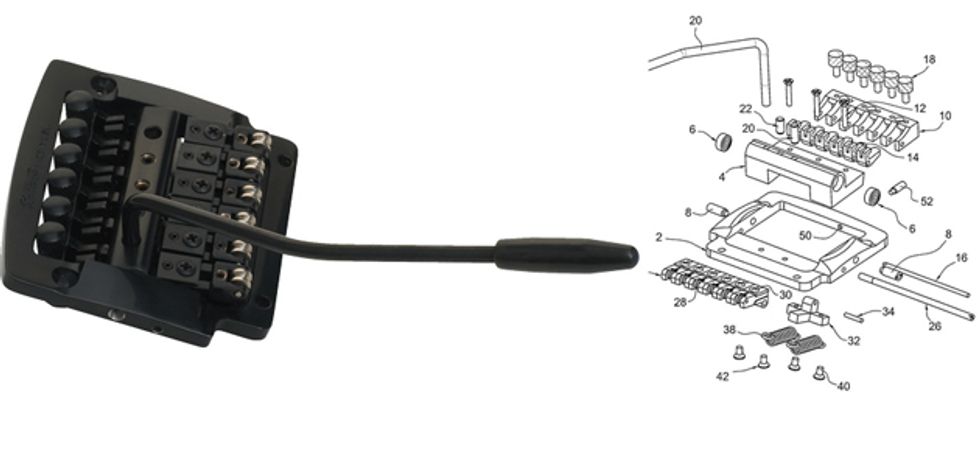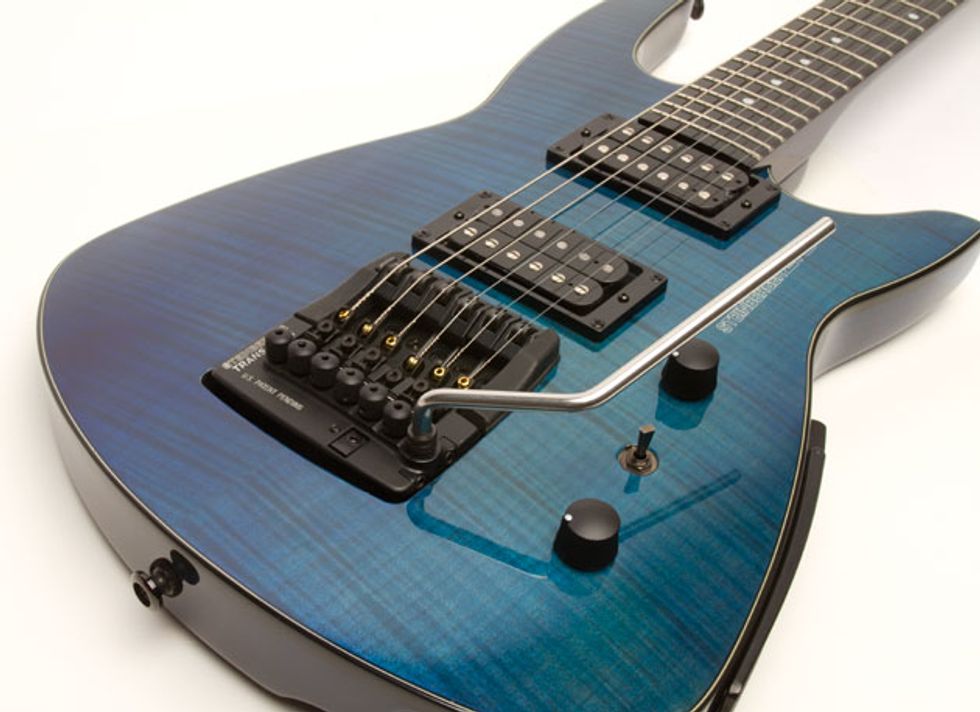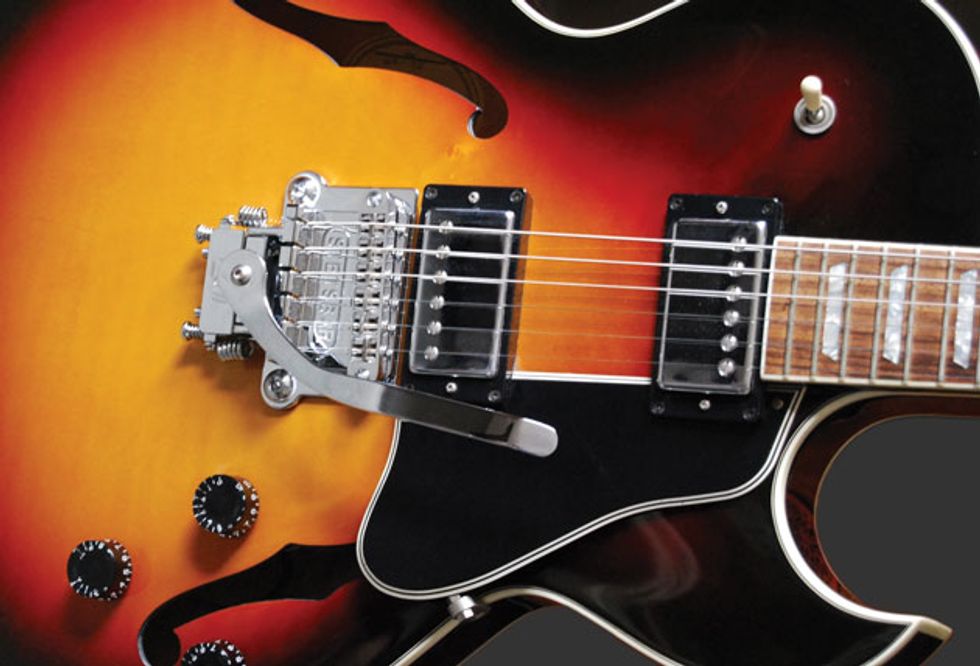A tribute to the visionaries of vibrato—from the brilliant minds that concocted its mechanics to the players who hooked us on its intoxicating effects.
Whether it’s used to add a shimmering vibe to a cloud of ethereal chords, impart a seasick feel to a surf riff, or unleash a sonic assault of bowel-rattling divebombs, the tremolo bar has played a huge role in the guitar’s capabilities as an expressive instrument. It’s difficult to imagine a modern musical genre that wouldn’t sound a lot different without the remarkable range of textures that a deftly used tremolo can yield. To celebrate the contributions of this wonderful piece of hardware—and the brilliant minds that made it possible—let’s look at the tremolo systems that changed not just the way guitar is played, but the entire musical landscape since the 1930s.
First, some nomenclature: Although many use the terms “tremolo” and “vibrato” interchangeably, they aren’t always synonymous. There are different types of tremolo: On bowed string instruments, tremolo can refer to rapid reiteration of the same note, or movement between two notes (sometimes called “tremolando”). This explains why the fast picking at around the 0:30 mark in Edward Van Halen’s “Eruption” is often called “tremolo picking.” But with some instruments, including guitar and organs, “tremolo” refers to a variation in volume—which explains why famous amplitude-modulating pedals like the Demeter Tremulator and Fulltone’s Supa-Trem2 are named as they are.
Confused yet? That’s only half the picture. Those who insist tremolo is a volume-related musical effect will tell you that, theoretically, vibrato refers to pitch fluctuation. But try keeping that straight in your head the next time you’re playing a Strat outfitted with Fender’s pitch-altering “Synchronized Tremolo” through a Twin Reverb equipped with the company’s deliciously hypnotic volume-modulating circuit labeled…“vibrato.”
The Good Doc’s Vib-Rola The tremolo bar’s origins go back to the 1930s, around the time the electric guitar was born. In 1935, Clayton Orr “Doc” Kauffman was aiming to replicate the sound of a Hawaiian steel guitar. He invented the Kauffman Vib-Rola, one of the first incarnations of a vibrato tailpiece. Initially, the Epiphone guitar company had exclusive distribution rights, even installing the Vib-Rola on some of its acoustic guitars. Before long, though, Rickenbacker (which still went by the original German spelling: Rickenbacher) took over the rights and began installing Vib-Rolas on its Electro Spanish guitars, as well as its lap-steel guitars. A little later, the Rickenbacher Vib-Rola Spanish, a variant of the Electro Spanish, featured a bar-less, motorized version of the Vib-Rola with knobs for speed and volume.
The Vib-Rola earned its place in the annals of tremolo-bar history by ending up on the 1958 Rickenbacker 325, which John Lennon used as the Beatles began their ascent to the pop throne. However, because the Vib-Rola was seemingly incapable of smoothly returning to correct pitch after even light use, it never became as timeless as the Fab Four’s discography. When Lennon returned to Liverpool, he went to Hessy’s Music Centre to have the Vib-Rola replaced with a unit that avoided many of the problems associated with Doc Kauffman’s design.
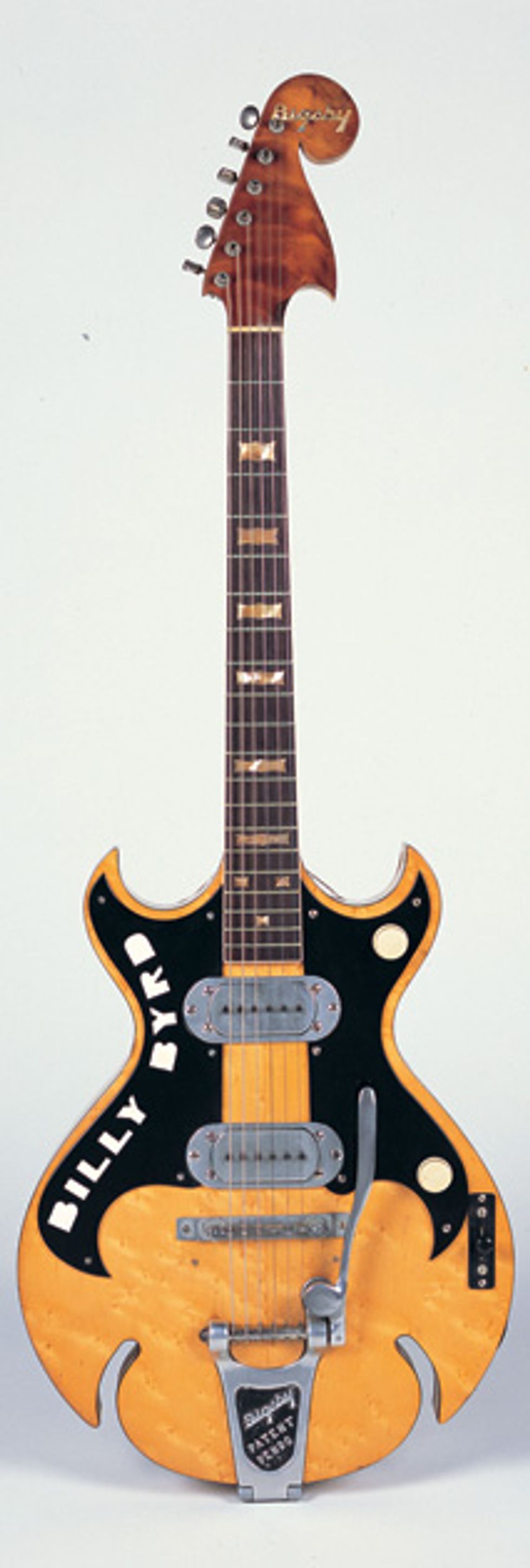
Tremolo pioneer Paul Bigsby finished work on this guitar for country session ace Jimmy Bryant on October 7, 1949, though it ended up going to Ernest Tubb sideman Billy Byrd. The vibrato—which is inset to be flush against the guitar’s top—was added not long after the design’s introduction in ’52. Photo courtesy of Bigsby/Fred Gretsch Enterprises, Ltd.
Vibrato Goes Big with the Bigsby Introduced in 1952 and patented in 1953, the Bigsby vibrato was the first successful production tremolo system. Although exact details of its chronology are a little sketchy, it seems legendary country picker Merle Travis became friends with guitar builder and fellow motorcycling enthusiast Paul Bigsby in 1944 or ’45. At some point Travis mentioned to Bigsby—who boldly proclaimed he could fix anything—that his Kauffman Vib-Rola-equipped Gibson L-10 wouldn’t stay in tune. Though it’s unclear whether Bigsby ever worked on Travis’s Vib-Rola, historians believe this interaction focused Bigsby’s mind on developing a better vibrato.
However, according to vintage-guitar guru Deke Dickerson, Travis obtained a custom Bigsby guitar—the first modern solidbody—in mid 1948, years before getting a Bigsby vibrato. It wasn’t until 1952 that Travis received Bigsby’s first vibrato unit. The future Country Music Hall of Fame inductee then had the aluminum-alloy design installed on his Gibson Super 400. Bigsby’s first guitar design to come equipped with the vibrato was the doubleneck he built for country guitarist Grady Martin in October 1952.
It didn’t take long for the vibrato system to gain popularity among guitarists worldwide. John Lennon’s friend Chris Huston, guitarist for Liverpool band the Undertakers, had a Gibson guitar with a factory-installed Bigbsy. Lennon liked Huston’s Bigsby so much that, in May of 1960, Huston contacted Paul Bigsby to request a unit for Lennon. One day in 1961, Lennon approached Huston with the news that his Bigsby had arrived. The pair went to Hessy’s and swapped out Lennon’s Vib-Rola for the Bigsby. There are many similar stories of music icons adopting the Bigsby.
Bigsbys are often found on hollowbody and semi-hollowbody guitars because the vibrato mounts to the guitar’s top and is less physically invasive than other systems. The Bigsby’s spring-loaded rocker arm attaches to a pivoting axle that the strings wrap around. The pull of the strings works in conjunction with the pressure of the spring. When the arm is pushed down, the bridge rocks forward and the strings loosen, lowering their pitch. When pressure on the arm is released, the strings return to pitch.
Although Paul Bigsby’s design improved on many of its predecessors’ shortcomings, it’s by no means a low-maintenance piece of machinery. Pre-1956 versions had a fixed-position vibrato arm that got in the way of strumming. Once the swivel arm was introduced, the bridge became much more popular. Even so, if you pull the bar up, there’s risk of the spring falling out. Additionally, string changes can be tricky and more time consuming than with some more modern designs. But for countless Bigsby devotees in genres ranging from country to rockabilly to indie rock, these inconveniences are a small price to pay for the smooth, undulating magic of a Bigsby.
Though the Fender Strat’s “Synchronized Tremolo” from 1954 is arguably the most-used vibrato system in the world (see the U.S. patent diagram at right), in the ’60s far more players were using the trem found on the company’s Jaguar (left) and Jazzmaster guitars. Photo by Tim Mullally
A Legend Is Born Perhaps the most enduring and influential solidbody vibrato is Fender’s Synchronized Tremolo, one of the many innovations introduced in 1954 with the debut of the Stratocaster. Countless solidbody trem variations have come and gone over the years, and nearly all of them owe a lot to Leo Fender’s masterpiece of engineering.
This design is what’s referred to as a “floating,” fulcrum-style tremolo. It can only be used with solidbody guitars, and it features a base with a steel block connected perpendicularly to its underside. This block extends downward into a cavity extending through the body. From the back of the guitar, strings are threaded through holes in the bottom of the tremolo block, which is visible through a route cut in a plastic plate. The same plate covers a shallower cavity where three to five springs connect the block to a “claw” screwed into the body. The two screws securing the claw can be loosened or tightened to adjust spring tension and accommodate different string gauges. The springs counterbalance the pull of the strings and facilitate the floating design, which can be set up to allow both downward and upward pitch bends. It can also be set up for down-only movement. In fact, to ensure that the bridge can’t go upward, some guitarists even wedge a block of wood between the steel block and the cavity wall.
The Synchronized Tremolo also enables action and intonation adjustments. Each string has its own saddle made of case-hardened stamped steel, and each saddle features two screws for adjusting string height. Behind each saddle is a screw that moves the saddle forward or backward to fine-tune each string’s intonation.
Despite all its advances, the Fender Strat trem still has limitations. Under extreme use, it typically has tuning issues. Some remedy the situation by making sure their Strat’s nut slots are smoothly cut and lubricated, or by reducing the number of string winds around the peg. Ultimately, though, some tuning compromises are virtually unavoidable if your playing calls for aggressive bar action.
Although today far more players use Strat tremolos, in the late ’50s and throughout most of the ’60s, Strat sales were in a major slump and other Fender models were selling much better. When the Jazzmaster guitar was introduced in 1958, it featured what the company touted as its “top-of-the-line” tremolo system. Unlike the Strat, the Jazzmaster had a separate bridge with six saddles, and the mechanisms of pitch transposition were mounted to a chrome plate set into a shallow cavity on the guitar’s top. The trem also had a slider to lock it in place to keep the guitar in tune in case of string breakage.
Introduced in 1965 on the Mustang guitar, Fender’s “Dynamic Vibrato” was mechanically similar to the Jazzmaster/Jaguar tremolo. Its redesigned bridge featured saddles with a single, deeper string groove that solved many problems with the prior setup, making it a popular upgrade for many Jazzmaster and Jaguar owners. Photo by Tim Mullally
In 1962 Fender debuted the Jaguar, which used the same floating trem as the Jazzmaster. Both guitars are infamous for their troublesome bridge designs, which often let strings slip out of their multi-ridged saddles under even moderate attack. That said, the design became integral to surf players, as well as guitarists who would use the instruments’ unique appointments as a foundation for more raucous styles in later years. Today, many players replace the original Jazzmaster bridge with a Mastery or Tune-o-matic-style bridge.
In 1965 Fender released the Mustang guitar, whose floating Dynamic Vibrato shared similarities with the Jazzmaster and Jaguar systems, though its bridge was mounted to the vibrato plate. While the Mustang’s bridge was similar to the one on Jazzmasters and Jaguars, its saddles featured a single, deeper groove that alleviated many of the earlier design’s problems. Introduced in 1967, the Bronco student guitar used a variant of the Strat trem called the Steel Vibrato, which had two pivot points rather than six.
A Gibson 1963 SG Custom with a Maestro Vibrola. Photo by Sellenman
Gibson Sideways and Maestro Vibrolas Some of Gibson’s most coveted guitars from the 1960s came with vibrato designs that looked handsome but were fairly impractical due to their limited range and tuning issues. First available in early 1961 on ES-355s and Les Paul SGs, the “sideways” Vibrola—so named because its jointed, foldable tremolo arm moves parallel to the body—is paired with a Tune-o-matic bridge, and its pitch-changing apparatus is encased in a long tray that extends from the bridge to the strap endpin. Under the tray’s elegantly molded cover, the handle connects to a mechanism that moves two piston-like springs on either side of the whole assembly. When the arm is activated, the springs alter the lateral position of the piece to which the strings are anchored (the section with the triangle-shaped hole). According to Lin Crowson, repair and appraisal specialist at Gruhn Guitars in Nashville, the amount of pitch variation possible with a sideways Vibrola varies by the tension adjustment on the two internal springs, though it can go anywhere from one-and-a-half to three full steps or more.
Available on Gibsons SG Specials in late 1961, the Maestro Vibrola was quite simple compared to other tremolos of the day. Viewed from its side, it is essentially a question-mark-shaped metal base that attaches to the guitar top with three screws. A separate piece of metal—the piece to which both the strings and the vibrato arm are secured—slides over the top of the curved “question mark.” Pushing on the arm changes the curvature of the base, thus altering tension on the strings. Gibson later introduced a model with a “Lyre” portion that extended from the bridge to the endpin, similar to the sideways Vibrola. In 1962, SG and SG Customs were also available with a version of the tremolo that had an ebony block with art-deco-like inlays behind the bridge. Both the Lyre and the block were purely cosmetic additions. According to Gruhn Guitars’ Lin Crowson, though the original Maestro Vibrola and ebony-block versions attach differently than the Lyre version, the mechanisms of pitch transposition are the same. All three offer a subtler vibrato effect than other designs, with treble strings being affected more due to their proximity to the point of arm attachment. Typical pitch changes can be from one-and-a-half to two-and-a-half steps, depending on the angle of the bar, string gauge, and how much spring is left in the metal.
A vintage Mosrite Ventures model featuring one of the earliest Vibramute tremolos. Photo by Deke Dickerson
Semie Moseley—Apprentice to the Stars In the late ’50s, Semie Moseley—a former apprentice to both Rickenbacker luthier Roger Rossmeissl and Paul Bigsby—started a quirky guitar company called Mosrite, which soon became a favorite of many country and rock musicians. One of Moseley’s first instruments was a doubleneck he built for country picker and TV star Joe Maphis in 1954. It featured an aluminum Vibramute tremolo. The Vibramute bears some visual similarity to a Bigsby but is exclusively top-mounted and has a foam-rubber string mute. Strings are fed through a string stop, to which the tremolo arm is connected, and mounted to saddles with individual string rollers that move with the string when the bar is used. A few years later, Moseley changed the trem to a die-cast design, did away with the mute, added a longer arm, and called the resulting model the Moseley tremolo. It appeared on popular Mosrite guitars such as the Ventures models used by the surf-instrumental icons, as well as Johnny Ramone.
Players Who Put Tremolo on the Map
Since the vibrato bridge’s invention nearly 80 years ago, creative guitarists have used it to change the vernacular of the electric guitar. Here we take a look at some of those tremolo-bar pioneers and the sounds they created.
Bigsby Bouncers
To this day, the Bigsby is one of the most popular tremolo systems on the market. It’s a factory option on guitars by Gretsch, Gibson, PRS, and others. Compared to more modern tremolos, the Bigbsy has a relatively limited range of pitch manipulation. However, those who swear by it do so because fulcrum- and cam-based designs with greater range simply can’t match the subtle charm, vintage vibe, and unique timbres that the Bigsby imparts. The image of a Bigsby-equipped hollowbody guitar through a reverb-drenched amp has withstood the test of time.
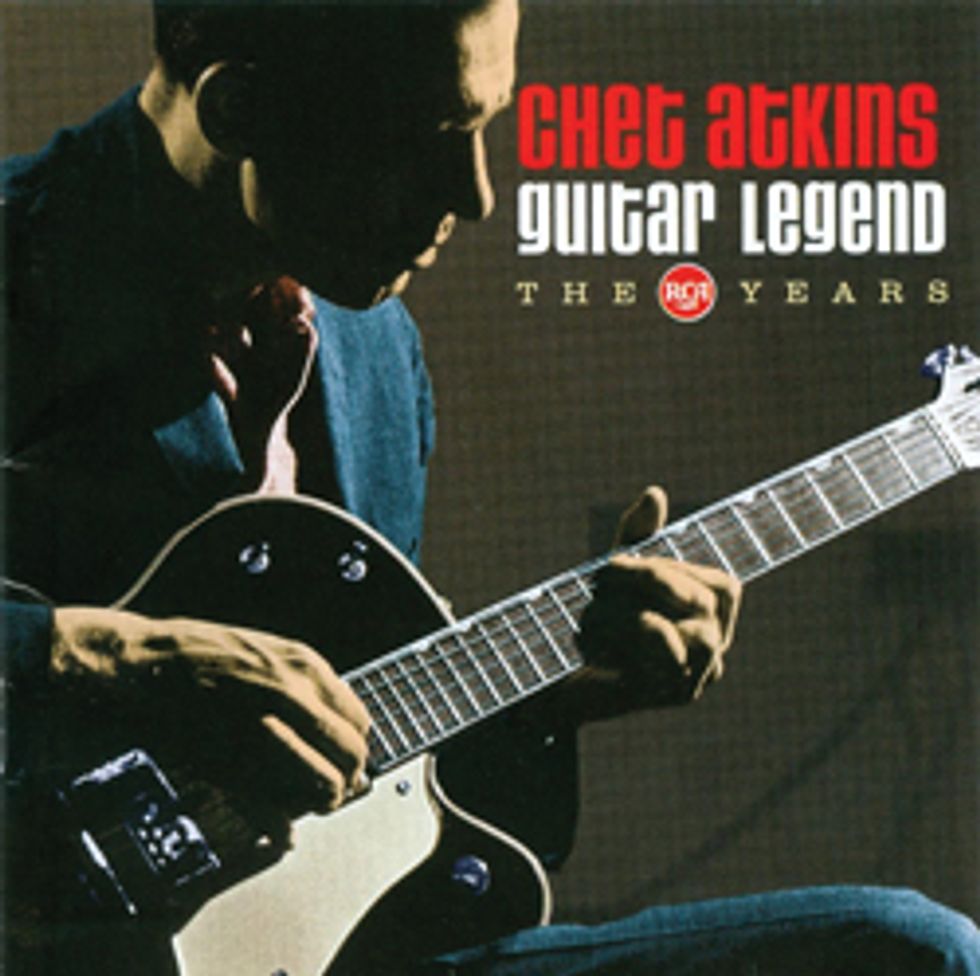
The Bigsby is often the trem of choice for rockabilly, country, surf, and indie rock players. Artists like Brian Setzer, Chet Atkins, and Duane Eddy have all made great use of it. Check out the warbles on Setzer’s “Stray Cat Strut” or his rendition of “Sleepwalk,” the gently rocking chord punctuations on Atkins’ “Mr. Sandman,” and the open-string Bigsby twang on Eddy’s “Movin’ n’ Groovin’.”
But when push comes to shove, the Bigsby can scream. Neil Young, “The Godfather of Grunge,” has never been one to treat the Bisgbsy with kid gloves—he mauls his Bigsby-equipped Les Paul like a metal maniac on tunes like “Cowgirl in the Sand”— and pretty much every other song at his live shows.
Fender Forefathers
The Strat’s Synchronized Tremolo system is almost as important to music history as the guitar itself. It paved the way for groundbreaking moments too numerous to count.
Perhaps the most memorable moment in Strat trem history was Jimi Hendrix’s jaw-dropping 1969 performance of the “Star Spangled Banner” at Woodstock. Jimi shook both guitarists and music fans to the core with his erotic, violent whammy bar attack, conjuring howling, swirling feedback and trills that dive-bombed into oblivion.
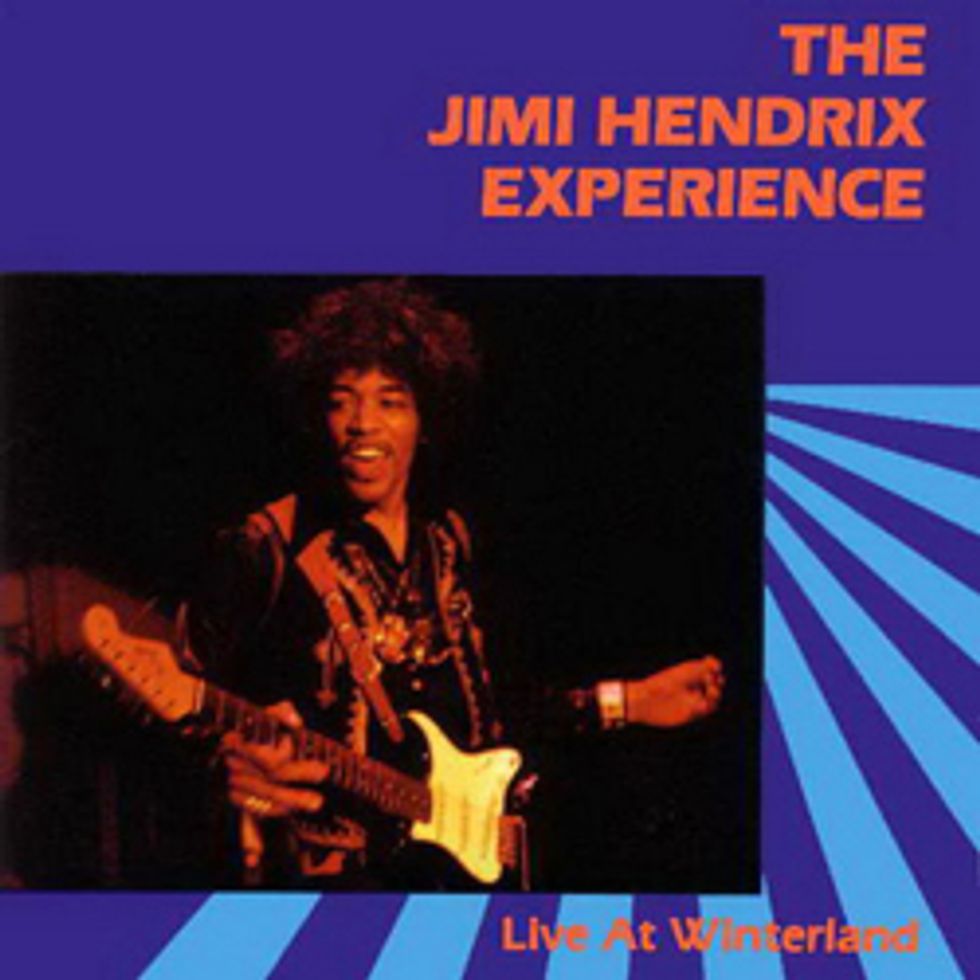
But it wasn’t Hendrix alone who immortalized Strat trem. From delicate, faux-slide sounds to soulful melodic caresses, Jeff Beck’s tremolo technique practically transforms the guitar into a new instrument. The former Yardbird sets up his Strat trems so they float, often gripping the bar with the tips of all his picking-hand fingers while plucking stings with his thumb and performing volume swells with his pinky. Listen to his tremolo bar work on songs like “Goodbye Pork Pie Hat” and “Where Were You.”
And let’s not forget the impact of Fender Jazzmaster and Jaguar tremolos on the ’60s surf sound. The Surfaris’ Jim Fuller and Bob Berryhill used Jazzmaster trem to fuel their megahit “Wipe Out”, while the Surftones’ Dave Meyers warbled his Jaguar’s tremolo to great effect on “Church Key.” More recently, Nels Cline used Jazzmaster trem to great effect on Wilco’s “Impossible Germany,” as did Kevin Shields on My Bloody Valentine’s “Come in Alone.”
Gibson Vibrola Fans
The “sideways” and Maestro Vibrolas developed by Gibson in the early ’60s weren’t terribly popular due to their limited practicality. However, Jimi Hendrix used a Maestro Vibrola-equipped Gibson Flying V for “Red House,” and today players such as Mike Campbell (Tom Petty and the Heartbreakers) and Wilco’s Jeff Tweedy still have great affinity for them. Campbell is often seen with a Maestro-outfitted Gibson Firebird, and Wilco’s Jeff Tweedy often wails the Maestro on his SG Standard on live renditions of “At Least That's What You Said.”
Mosrite Surfers
When Semie Moseley loaned a guitar to Ventures guitarist Nokie Edwards for a recording, both the band and Moseley’s Mosrite guitars skyrocketed to fame. When the band used the instruments live to play hits like “Walk Don’t Run,” with its tremolo shimmies on the held C note at the end of the iconic riff and the chords that follow it, it cemented the Mosrite tremolo’s place in whammy bar history.
Floyd Abusers/Gods
Using a standard Fender trem, Eddie Van Halen eviscerated rock guitar fans with his paradigm-shifting 1978 instrumental, “Eruption.” But his extreme pummeling of the bar soon led him to embrace double-locking tremolos for better tuning stability. By the second Van Halen album, he’d adopted the Floyd Rose and ushered in a new era of bizarre bar antics that, along with tapping and screaming harmonics, set the standard for guitar mastery in the ’80s. There are too many examples to cite, but the Floyd Rose-driven insanity in his solo for Michael Jackson’s “Beat It” is perhaps most indicative of his impact.
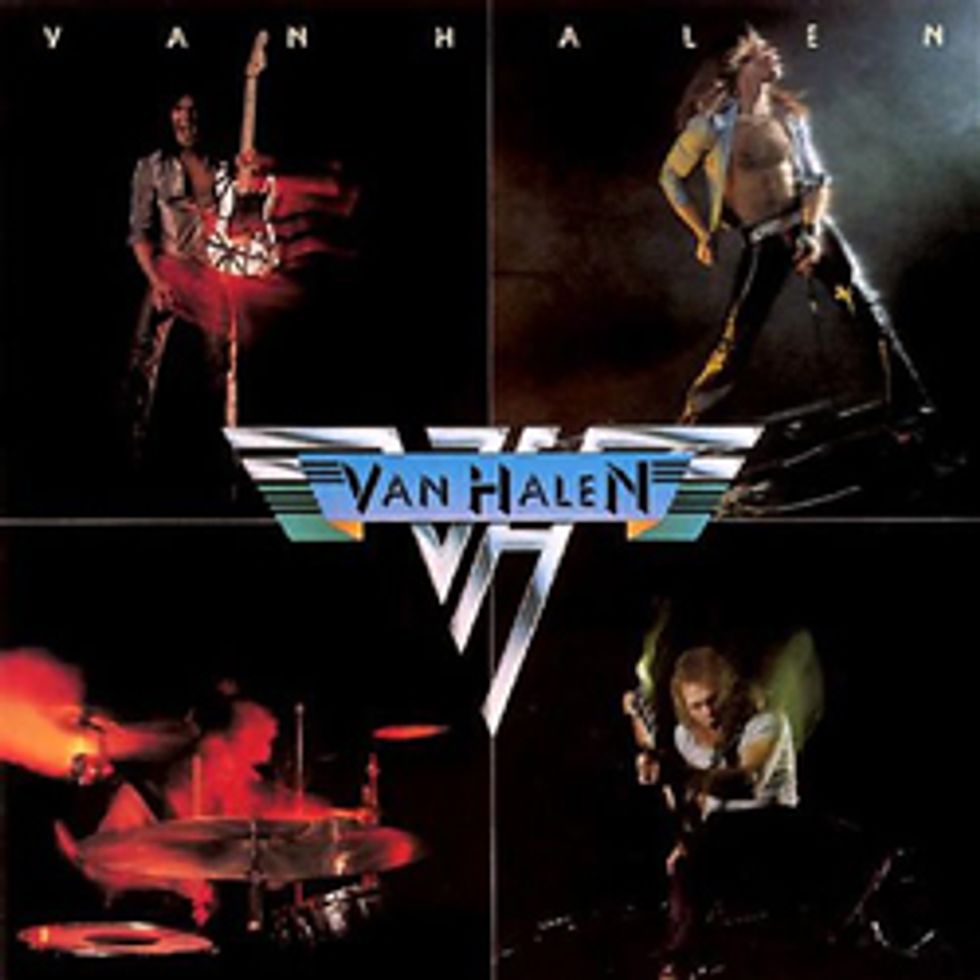
As the shred era caught fire, the guitarist David Lee Roth recruited after exiting Van Halen also carved a career out of whammified sounds. Dissatisfied with the upward range on his Floyds, Steve Vai used a hammer and screwdriver to chisel the area behind the bridge of his Charvel “Green Meanie” so he could pull the bar up further. He took advantage of this newfound range to achieve stratosphere-scraping squeals on songs like the odd-meter-laced “The Attituide Song.” After joining Roth’s solo band, Vai used the bar in combination with a wah pedal to create a wild vocal effect on their first single, “Yankee Rose.” For many players, it expanded the horizons of whammy use.
Interstellar Travelers of the TransTrem
Ned Steinberger’s TransTrem also offered a goldmine of riches for outside–the–box artists like Allan Holdsworth, who used the transposing vibrato to augment his already befuddling harmonic tapestries for an effect similar to what synth players get with a pitch wheel. To this day Holdsworth uses TT2 and TT3 TransTrems cannibalized from older Steinbergers on axes built by Canton Custom Guitars.
Because of its complexity, some dismissed the TransTrem as a niche piece of gear for esoteric styles. But Eddie Van Halen shattered such notions by employing the TransTrem in a straight-up hard rock setting. Van Halen used a pin-striped, TransTrem-equipped Steinberger GL on songs like “Get Up” and “Summer Nights” from 5150, the first Van Halen album with Sammy Hagar as lead vocalist.
A set of Original Floyd Rose trem parts (above left, photo courtesy of Banzai Music) and part of the original 1979 U.S. patent diagram filed by Rose on October 23, 1979 (above right).
The Floyd Rose Revolution In 1977 Floyd Rose designed a fulcrum-style vibrato bridge that aimed to achieve better tuning stability than Fender’s design. The “double-locking” tremolo that bears his name allows users to clamp each string at the bridge and the nut. The Floyd Rose played a significant role in shaping the sound of ’80s rock, facilitating over-the-top guitar histrionics by allowing an unprecedented amount of whammy-bar abuse while meticulously maintaining the guitar’s tuning. In some ways, the design is as integral to hard rock and metal as Marshall and Mesa/Boogie amplifiers, and high-output pickups by the likes of DiMarzio and EMG.
Rose was inspired to develop his bridge after applying Krazy Glue to his Strat’s strings after they were tuned to pitch. Before long the tuning problems returned, so he tried a more permanent strategy: He rented machinery to make locking nuts and bridges. When Randy Hansen—an infamous Jimi Hendrix impersonator and noted whammy-bar abuser—got a hold of the second Floyd Rose prototype, he found that his guitar remained perfectly in tune even after he stomped on the bar and then tossed the axe in the air, catching it by the bar. That’s when Rose knew his device would be a game changer—though it was the next Floyd owner who put the trem on the map.
Rose’s friend Linn Ellsworth of Boogie Bodies was making guitars for Eddie Van Halen, the world’s biggest guitar hero at the time. Rose showed Van Halen the unit and he was quickly sold. Rose struck a deal with Kramer guitars to be the exclusive distributor of the trem despite the fact that the guitar manufacturer had planned to use the Rockinger trem, a locking-nut design that they had referred to as “the Eddie Van Halen tremolo.” Van Halen’s iconic, Floyd-equipped “Frankenstrat” went on to become the decade’s defining axe, and Floyd Rose mania ensued.
The Floyd Rose consists of a floating bridge and a locking nut. Unlike conventional bridges that rely on the ball end to keep the string in place, the Floyd Rose necessitates cutting off the ball end just above wrappings. The string end is inserted in a saddle, and a small metal block clamps the strings in place when you tighten the 3 mm hex screw at the back of the bridge (in the same location as a Strat bridge’s intonation screw). Up at the nut are three square pieces of metal, each of which tightens down on a pair of strings via another 3mm hex screw once the guitar is tuned. When the strings are locked in place, the headstock tuners have no effect on tuning. However, small adjustments (roughly a whole-step’s worth) can be made via fine tuners at the rear of the bridge. One downside of the fine tuners: Because of their location, they can sometimes obstruct a player’s picking hand, particularly if the player rests their hand on the bridge.
The biggest pitfall of the Floyd Rose, however, is that if it is set to float and a string breaks, the whole guitar will go out of tune. Because of this—and the fact that changing a string on a Floyd Rose-equipped guitar takes longer than on many other bridge designs—many Floyd users always bring backup guitars to gigs.
An example of Kahler’s cam-based locking-tremolo design (above left, photo courtesy of Banzai Music) and part of the company's U.S. patent diagram (above right).
Kahler’s Threat to the Kingdom of Floyd Perhaps the most direct competitor to the Floyd Rose was the tremolo designed by Gary Kahler. In the late ’70s Kahler had a guitar hardware company called Brass Factory that made brass versions of the Fender trem and developed several bridges with Fender. In the ’80s Kahler changed the company name to American Precision Metalworks and soon unveiled the Kahler tremolo.
The Kahler trem had several unmistakable Floyd-inspired design features, including a locking nut and fine tuners on the bridge assembly—enough to warrant a patent-infringement judgment against Kahler. Unlike the Floyd Rose however, the Kahler is a cam-based system—strings attach to a single cylindrical cam inside the bridge housing. Furthermore, Kahlers didn’t require snipping the ball ends off of strings.
The battle raged between Floyd Rose and Kahler throughout the first golden age of shred, with many flashy players pledging allegiance to one system or the other. In the end, Kahler lost a patent-infringement lawsuit and the balance of power went to Floyd. In 2005, however, Kahler began manufacturing bridges again under Floyd Rose licenses.To this day, the company has produced over a million trems.
The Steinberger ZT-3 guitar introduced in 2008 featured the third version of Ned Steinberger’s innovative TransTrem design, which keeps entire chords in correct pitch during use and lets you lock the bridge in six different keys.
Beyond Tuning Stability As double-locking trems grew in popularity, numerous aftermarket add-ons emerged. Some players who preferred the vintage feel, low profile, and less-complicated operation of Strat-style bridges turned to locking tuners and more sophisticated and finely tuned fulcrum designs by the likes of Wilkinson, or the John Mann-designed bridges on Paul Reed Smith guitars. Meanwhile, some shred-oriented guitar brands developed their own versions of the double-locking recipe, as Ibanez did with its many iterations of the Floyd Rose-inspired Edge tremolo. Most of these, however, owed a debt to Floyd Rose designs and were marked with language such as “Licensed under Floyd Rose Patents.”
Floyd Rose developed new designs, too, including the SpeedLoader, which eliminated the time-consuming need to snip off the strings’ ball ends, though it necessitated buying proprietary strings. Eddie Van Halen’s EVH brand also released the D-Tuna—a simple device that replaces the string-locking screw of a Floyd Rose’s low-E saddle and that, when pulled, instantly lowers the string’s pitch to D.
Ned Steinberger took the locking and detuning concepts even further with 1984’s Steinberger TransTrem bridge. The TransTrem, an evolution of his original S-Trem design, appeared on Steinberger headless guitars. It used special double-ball strings (though a single-ball string adapter was later offered) and allowed entire chords to stay in tune as the bar was manipulated. Perhaps the most unique feature of the TransTrem was that it allowed you to raise or lower pitch with the bar and then lock the bridge in place in order to play in six different keys—as far down as a perfect 4th (B-standard tuning), or up a minor 3rd (G-standard).
Headless guitar manufacturers like Klein made the TransTrem standard equipment on their designs. After Steinberger stopped producing TransTrem-equipped guitars, the trems themselves became hot commodities, fetching upwards of $1,000 on eBay. The scarcity and expense proved to be a significant impediment to headless guitar manufacturers, who turned to alternate solutions such as JCustom’s recently released XS-Trem, a direct replacement for the Steinberger S-Trem. Since then, manufacturers such as Carvin have explored headless guitars, including the Allan Holdsworth HH1 and HH2.
In 2008 Ned Steinberger introduced an updated version called the TransTrem 3, which coincided with the release of the Steinberger ZT–3 guitar.
The Stetsbar mounts to guitars with a Tune-o-matic-style bridge without requiring any drilling.
Going Where No Trem Had Gone Before For a long while, the evolution of vibrato bridges seemed to coincide with the development of more modern playing styles. But many Les Paul and Tele fans secretly longed to join the whammy parade without sacrificing what they love about those unique guitar designs. However, those with vintage instruments were apprehensive about permanently modifying them, because any irreversible modification would severely impact a guitar’s value. Thankfully, many innovations have come to market to address these concerns.
Back in the ’80s Eric Stets wanted a trem on his ’71 Gibson Les Paul Custom but didn’t want to drill holes in it. He subsequently designed and patented the Stetsbar, which fits existing bridges and doesn’t require any guitar modification. He also offers versions for Strats, Teles, and other guitar designs. Meanwhile, the Vibramate kit lets Bigsby fans mount the spring-powered legend to the studs of a stop-tail bridge without drilling. For Teles, you simply swap your “ashtray” bridge assembly with a modified Vibramate bridge that fits in the existing holes. It connects to a tailpiece secured by the strap endpin. The Bigsby mounts on the tailpiece rather than the guitar body.
To Infinity and Beyond Though they’re the unequivocal benchmarks of vibrato design, the models discussed here are only the tip of the trem iceberg in terms of sheer numbers. Likewise, the players mentioned are merely those most immediately associated with each device them in the broader guitar consciousness. Countless other players have enriched our lives with inventive, soul-touching vibrato work.
As with everything in our gear universe, nothing will stop the wheels of change. Given how far tremolos have come, it may seem difficult to fathom where designs could go next. But at least one company seems poised on the brink of the future. EverTune’s tension-monitoring bridge wowed guitarists the world over in 2010 with its promise to never let a guitar go out of tune, regardless of temperature, climate, or heavy-handed playing. At press time, the company told us they are about a year away from offering a tremolo version that’s sure to make waves.
And yet the designs we’ve come to love, whether vintage or modern, are sure to remain popular for a long time to come. Whether you’re the one wiggling that bar, or the one enjoying it from the crowd, there’s no denying the power of the tremolo.
